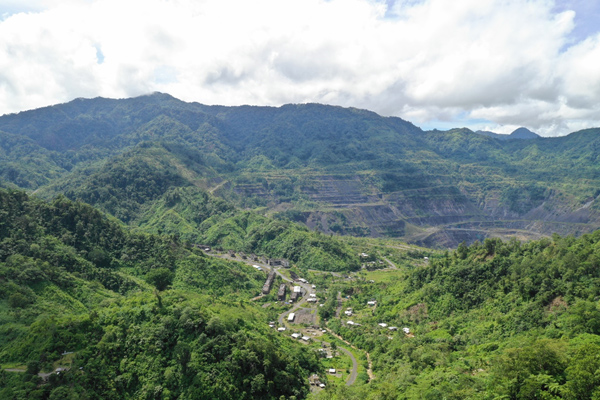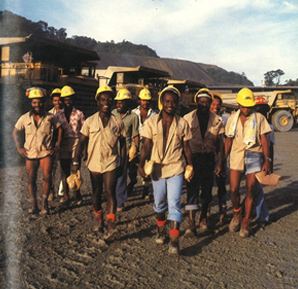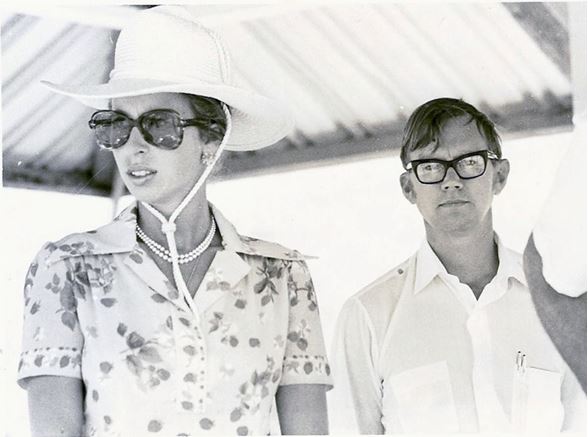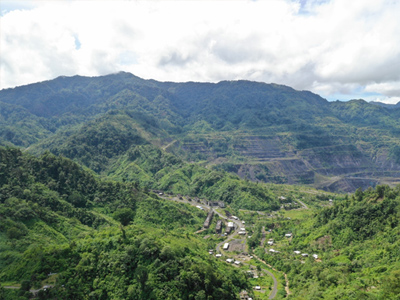Former workers share Panguna thoughts with BCL’s editorial team.

Over the picturesque, green jagged terrain of Bougainville’s Crown Prince Range, the Panguna mine has sat idle for more than 30 years.
It is a mine with a chequered and somewhat haunting past due to its association with some of the island’s darkest days. Tracing its history takes us back to 1966 when intrepid geologists confirmed the existence of vast copper and gold ore deposits in the Panguna valley. By 1972 the mine was in full operation under Bougainville Copper Limited (BCL), a subsidiary of mining giant Rio Tinto, formerly CRA.
On the 15th May 1989, production came to a halt as a result of militant activity which escalated into a civil war. Land rights and the distribution of Panguna mining profits were among some of the issues central to the hostilities.
In the 17 years prior to 1989, the mine produced concentrate containing 3 million tonnes of copper from one of the largest concentrations of copper phosphate anywhere in the world. In addition, Panguna also yielded 306 tonnes of gold and 784 tonnes of silver. The mine had a production value of 5.2 billion Kina and accounted for 44 per cent of PNG’s exports during its period of operation.
Around 1.2 billion Kina was contributed in taxes, duties, dividends and other payments to the PNG government, the former North Solomons Provincial Government and Panguna landowners which represented about 62 per cent of the net cash generated by the project.
During the mine’s life, Bougainville Copper also trained some 12,000 employees, including around 1,000 full trade apprentices and some 400 who completed tertiary studies. This upskilling enhanced the capacity of the national workforce and benefited other areas of the economy after Panguna’s closure. The practices put in place by Bougainville Copper continue to positively impact the global mining industry to this day.
Spiral of roadways

To visit the immediate Panguna area now, it is hard to imagine that this quiet, peaceful and largely deserted location was once the focal point of one of the world’s leading mining operations. There are however the tell-tale signs in the form of abandoned buildings, mining equipment and other infrastructure. At the epicentre of course is also the disused mine pit itself with a spiral of roadways leading down to the bottom where an emerald green pond sits vivid and still.
In its heyday, the mine benefited about 30,000 people both directly and indirectly in the project region. This included employees and their families as well as others who provided goods and services and landowners who received royalties and land access compensation. The villages in the project area were lively places and visiting workers, including those who resided in nearby Arawa on the coast, recall a tropical paradise where people worked hard but also got to enjoy their downtime in one of the most beautiful places imaginable. Boating, fishing, diving and swimming were popular pass-times along with other sports like rugby, soccer, tennis and golf.
Many former Bougainville Copper employees still fondly reminisce about their days on the island, memorable parties and the forging of life-long friendships. It is not uncommon to hear them describe working at Panguna and living on Bougainville as “the best times of my life”.
Bougainville Copper had developed Arawa Town largely from scratch. The company invested heavily in infrastructure that not only benefited the mine but also the general community. New housing, roads, medical facilities, including a 300-bed Arawa General Hospital, schools, port facilities, airstrips as well as spending on electricity, water and telecommunications infrastructure was all supported by the mine. The company also established an ambulance and fire service and the construction of the Port Mine Access Road was considered a major engineering feat by international standards.
More than 10,000 Bougainvillean and Papua New Guineans were employed during the Panguna project’s construction phase both in the immediate mine area as well as in Arawa Town and throughout the region, providing a valuable source of local economic stimulus.
By December 1988, Bougainville Copper had 3,560 on its payroll of which 83 per cent were PNG nationals. Actual direct employment numbers showed a steady decline as the 1980s progressed, which reflected a commitment to engage more locally-based contractors for the provision of mining services. The number of overseas workers also declined as a result of training and the localisation of the workforce. Jobs at Panguna were sought-after as locally-engaged mine workers benefitted from wages and conditions above the national standard with subsidised housing, medical insurance and education part of the package.
Many notable visitors

Pictured: Princess Anne and Gregor Erikson in Panguna, circa 1974
Panguna’s reputation globally as a first-rate mining operation attracted many notable visitors to Bougainville during its years of operation such as members of the British Royal Family, including Queen Elizabeth and Prince Philip as well as Princess Anne and Captain Mark Phillips. Celebrated novelist Hammond Innes also visited along with several well-known entertainers, including musician Col Joye, comedian Barry Humphries and the Trinidad Cavaliers Steel Orchestra to name a few.
Notwithstanding the later tensions that resulted in the mine’s premature closure, former employees who lived and worked in the mining community also recall a harmonious place where people of different cultures and ethnic background happily co-existed.
Mr Paul Wagum who worked as an official photographer for Bougainville Copper said he did not experience or observe any instances of racial or ethnic tension. “A Bougainvillean would share a room with a Tolai and likewise a Chimbu shared a room with a Sepik and we didn’t have any issues. We worked, played, ate and drank together,” he says.
Mr Wagum also singled out the Bougainville Copper training program for special mention describing it as truly world-class for the way in which it converted those who dropped out of school early into professional mine workers and operators. He says this was a great Panguna legacy.
“The grade 8 students who could not be selected to go into grade 9, and the grade 10 students who could not be selected to go to universities or colleges, and even the university drop outs; they all ended up at Panguna and Bougainville Copper developed them into professionals,” Mr Wagum recalls.
“By the time the mine closed most of the general foremen in the concentrator as well as the mine were grade 8 leavers – a testimony to the superior training that was provided.”
Charmed by PNG

Another former employee, Mr Rocky Roe, came from Adelaide, Australia to Bougainville in 1976 to work as a mechanical fitter. He was so charmed by PNG that he calls Port Moresby home today.
“I did my fitting and turning apprenticeship with Chrysler Australia, and we had a well-equipped training centre, everything was well maintained, but the equipment we were training on was quite old. Some years later I ended up at Bougainville Copper and all the equipment in the training centre was brand new, top quality and top brands, I was stunned. And that’s how they produced such good staff,” he says.
“As a result, many great tradesmen were produced, you can actually find lots of ex-BCL staff at OK Tedi, Misima Mines and Lihir Mines.”
While the closure of the mine deprived many other young Papua New Guineans and Bougainvilleans of training and employment opportunities, Bougainville Copper had also previously established a significant education support initiative, as part of its corporate social responsibility program, that continues to provide sponsorship for local students to this day.
The not-for-profit Panguna Development Program – now known as the Bougainville Copper Foundation (BCF) – has funded more than1,300 tertiary scholarships since 1997, in disciplines such as engineering, medicine, law, education and business that will directly benefit Bougainville’s development, as part of its corporate social responsibility program.
BCF beneficiary Ms Marisa Kuypers says thanks to scholarships she now works as an IT Business Systems Analyst in the aviation industry and her sister fulfilled her dream of becoming a doctor.
“Our father died during the Bougainville crisis and we lost our mother in 1999 and we had nowhere to turn to, we were broken and didn’t have our parents to pay for our school fees,” she explains.
“We had loving relatives who provided us with basic love and care but this was not enough as they also had their own commitments, so we applied for the BCF scholarship. BCF has given me the opportunity in life by allowing me to complete my education and I will always be grateful.”
Ms Kuypers was also inspired to undertake further studies and is now completing a Masters in Information Technology at the Queensland University of Technology.
An active presence

So, what of Bougainville Copper today? It maintains an active presence in Bougainville and is now an independently-managed PNG company, after Rio Tinto fully exited in mid-2016 gifting their shares to the Autonomous Bougainville Government and the Government of Papua New Guinea.
As a result, Bougainville Copper is now predominantly owned by Papua New Guinean’s and Bougainvilleans with the PNG National Government and Autonomous Bougainville Government each holding 36.4 per cent of the shares.
It is very much a company with a renewed identity and purpose which is to support Bougainville’s growth and development. This includes working cooperatively towards realising the vision of one day resuming active exploration and sustainable mining at Panguna.
In the interim, the company is continuing to support a range of worthwhile community initiatives in Bougainville in areas such as education, health, sport, culture and industry development.
It is both true and understandable that for many, scars from Bougainville’s past run deep, and to others fond memories of what used to be at Panguna also endure.


